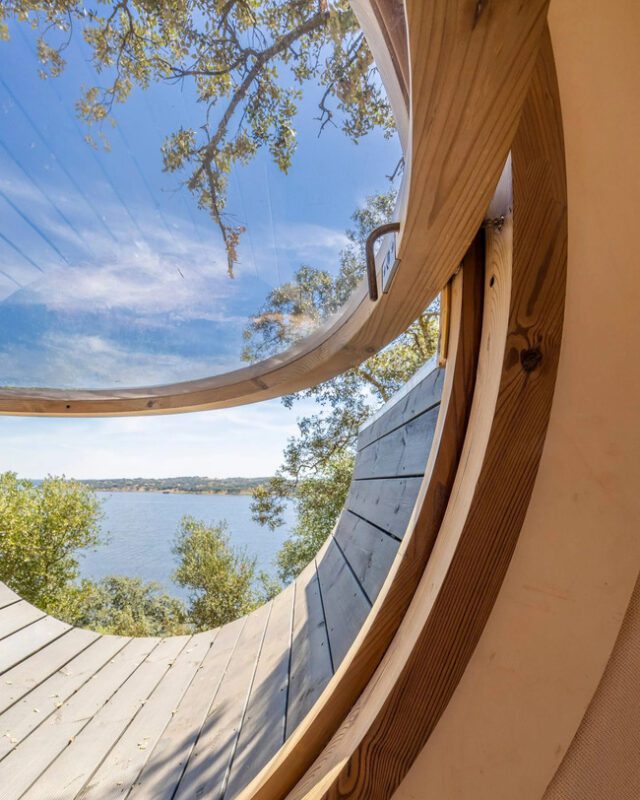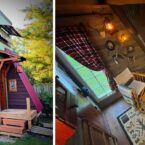
Mason Smith, affectionately known as thedadsocial, has captured the hearts of millions with his thoughtful and creative projects, shared with his over 3.8 million TikTok followers and nearly 3.5 million Instagram followers. Smith’s content is celebrated as a refreshing display of healthy masculinity and exemplary parenting. His latest project—a charming, child-sized camper—has particularly resonated with his audience. Inspired by his daughters, Continue reading “Loving Dad Builds Adorable Child-Sized Camper for His Daughters” »

The fashion and textile industries contribute approximately 10% of global landfill waste, with much of this waste being non-recyclable. Synthetic textiles such as polyester, spandex, and nylon are particularly problematic because they release microplastics into the environment and are not easily processed by standard recycling facilities. While there are existing methods to recycle these materials, the challenge intensifies when they are blended with natural fibers like Continue reading “A Polyester-Dissolving Process Could Make Modern Clothing Recyclable” »

The Open House, designed by KWK Promes, is a unique German residence that masterfully balances openness with privacy. Situated near Bremen, this innovative home allows its occupants to fully engage with the surrounding natural landscape while providing a mechanism to shut off from the world when necessary. The house features movable walls that can be adjusted with the flick of a switch, offering the flexibility to either open up to the forested surroundings or close off for privacy during social and sporting events that frequently draw visitors to the area. These long, curving walls are mounted on small wheels and operated by an electric motor, exemplifying a seamless blend of architectural ingenuity and practical functionality.

The strategic design of the Open House ensures that the residence remains integrated with its environment while accommodating the dynamic nature of its location. As KWK Promes explains, the house is located at the edge of a village, adjacent to a forest, which normally provides a quiet, secluded atmosphere. However, during sports events, the area becomes bustling with activity, necessitating the need for temporary closure without disrupting the natural flow of wildlife. The home spans nearly 2700 sq ft and includes two bedrooms, a living room, a mezzanine, a kitchen, and bathrooms, all within an open layout that features extensive glazing to enhance the connection to nature. The design is influenced by local architectural traditions, featuring whitewashed walls and a thatched reed roof with custom openings for improved ventilation. Solar panels power the home, ensuring an eco-friendly energy source, though the exact capacity of these panels remains unspecified.





Tried and tested by the some of the best outdoor adventurers, Kent Survival and Simon a Bloke in the Woods, it is loved by so many. This is a great bit of kit when you start that journey into outdoor cooking. Continue reading “The Original Grill Mini Fire Anchor” »

The Internet’s Favorite Sourdough Starter!
This diabolical starter traces its roots back to the San Francisco gold rush (really!!) but has been living and mingling with Kensington Markets eclectic denizens for the past several years, and has now mutated into its own beast! it’s been in continuous use since 1850! Continue reading “150 year old San Francisco Sourdough Starter” »

Artist Sergiu Ciochină captures the charm of European cities in his textured paintings by focusing on more than just iconic landmarks. Based in Paris, Ciochină finds inspiration in everyday scenes, such as the colors of buildings and the interplay of light and shadows on various surfaces. His paintings, while based on real elements like buildings, flowers, and streets, transcend mere replication of photographs. Instead, he uses these elements as a springboard for his creative process, blending observation with artistic interpretation to produce unique landscapes. “None of them can be called copies of photographs,” Ciochină explains. His work is a fusion of creativity, technique, and personal vision, resulting in pieces that offer viewers a new perspective on familiar settings.

Ciochină’s artistic approach is as diverse as his sources of inspiration, which he finds in unexpected places during his daily life and travels. Originally from Moldova, his move to Paris has profoundly influenced his style, pushing him towards realism and a deeper exploration of light and shadow in architecture. He uses various materials, including oil paint, acrylic, pastel, and charcoal, to achieve his desired effects. Despite the influences and comparisons to masters like Van Gogh and Monet, Ciochină strives to establish a distinctive visual language. “I have developed my style, and I am happy to continue developing it,” he states. His ultimate goal is to bring joy to those who appreciate his art, enhancing their lives and homes with his unique vision of Europe’s beauty. Follow him on Instagram to stay updated on his latest works and exhibitions.







If your favorite fashion icon is Slash from Guns N’ Roses and you appreciate quality craftsmanship, you should check out Spanish haberdashery Blade Hats. Marcos Souto, the owner of Blade Hats, is a master craftsman who handcrafts rock-and-roll hats with skulls on top, blending traditional millinery techniques with bold, modern designs. Watching Souto in action is impressive; he meticulously cuts, steams, and hand-molds fabric over wooden hat blocks before hand-sewing embellishments onto his bespoke creations. Inspired by 80s heavy-metal rock bands, Souto’s hats feature distinctive skull motifs, metal chains, and even playing cards, attracting customers from around the globe. Each hat is a unique piece of art, showcased through his engaging social media posts. In one video, Souto even lights his work on fire, using the flames to create a velvety texture and the perfect amount of distress, demonstrating his innovative approach to hat-making.

The techniques Souto employs were once the industry standard but fell out of favor with the advent of mass manufacturing and the rise of department stores in the late 19th century. Artisanal hats like those from Blade Hats have become rare, with each hat taking about three to five months to complete due to the labor-intensive process. Thanks to the magic of social media, fans can witness the entire creation process condensed into the length of a Metallica song, highlighting Souto’s exceptional skill and dedication. Even Slash owns one of Blade Hat’s designs, a testament to their rock-and-roll appeal. If you’re considering trading in your baseball cap for custom headwear, Blade Hats’ offerings range from about $485 to $1,500 and can be viewed on their website, promising a unique and stylish upgrade to your wardrobe.



The burgeoning demand for nickel, driven by the rise of electric vehicles (EVs), has prompted innovative approaches to resource extraction, with phytomining emerging as a notable solution. Phytomining leverages the natural ability of certain plants to accumulate metals like nickel from the soil, thus offering a more sustainable alternative to traditional mining. Plants such as Odontarrhena decipiens can concentrate up to 2% of their biomass in nickel, enabling the extraction of significant quantities of the metal without the environmental toll associated with mining. This method involves growing these Continue reading “Flower Farm Could Supply Nickel for Electric Vehicle Batteries” »

The Terra m1_Tiny House on Wheels by Portuguese woodworking specialist MadeiGuincho stands out with its unique design and efficient use of space. This compact tiny house measures just 5 meters (16.4 feet) in length and is designed for couples or individuals seeking a short vacation in the scenic Alentejo region of Portugal. The house features a charming curving roof reminiscent of traditional Vardo Romani wagons, adding a touch of nostalgic elegance. The roof’s barrel vault form not only enhances the aesthetic appeal but also serves a practical purpose by providing a terrace area for relaxation. The exterior is partly clad in cork and timber, blending harmoniously with the natural surroundings. Mounted on a double-axle trailer, the house also includes a small deck area, expanding the living space into the outdoors.

Inside, the Terra m1_Tiny House on Wheels is thoughtfully designed to maximize functionality and comfort within its compact dimensions. The main sleeping area on the ground floor features a double bed, while wooden steps lead to an additional loft space above the entrance, which can serve as a bedroom or storage area. The interior is finished in warm wood tones and includes a combined seating and storage area, a small kitchen, and a wood-burning stove for heating. Porthole-style windows add to the nautical theme and allow natural light to flood the space. The largest window, located above the main sleeping area, opens onto the roof terrace via removable steps. This snug terrace offers a cozy spot for relaxation, shaded by a nearby tree, making it an ideal place to unwind with a book. MadeiGuincho continues to impress with its innovative designs, creating unique and functional tiny homes that cater to modern needs while retaining a distinct stylistic charm.

























































